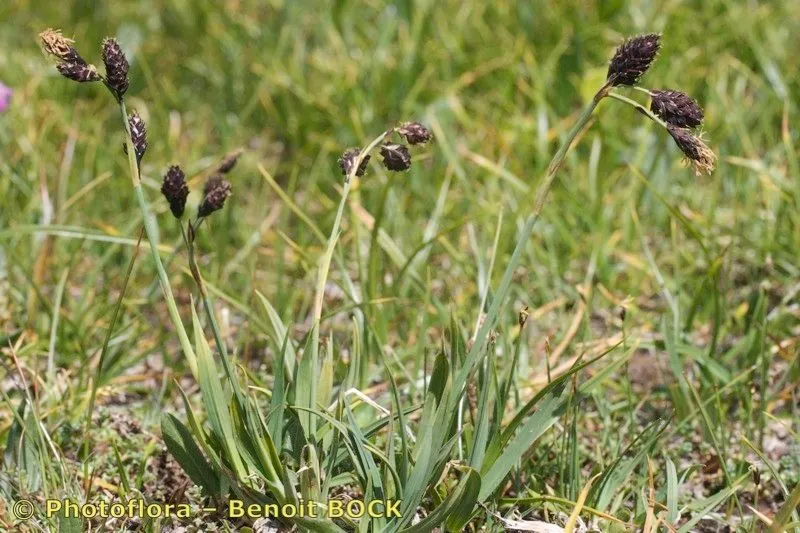
Author: Schkuhr
Bibliography: Beschr. Riedgräs. 1: 106 (1801)
Year: 1801
Status: accepted
Rank: species
Genus: Carex
Vegetable: Unknown
Observations: Subarctic to Temp. Northern Hemisphere
The darkbrown sedge, scientifically known as Carex atrofusca, is a resilient and intriguing species of sedge belonging to the family Cyperaceae. First described by Schkuhr in 1801 in the “Beschr. Riedgräs.”, this plant is a noteworthy member of the diverse genus Carex.
Carex atrofusca is predominantly found in subarctic to temperate regions of the Northern Hemisphere. Its presence spans across various countries, thriving particularly well in cold, wet environments, which is indicative of the plant’s adaptability to different climatic conditions. This geographical distribution highlights its ability to endure and flourish in both less hospitable subarctic climates and the more temperate zones, making it a species of interest for botanical studies focused on adaptability and resilience.
Visually, the darkbrown sedge is characterized by its distinctive dark brown to almost black inflorescence, lending it the common name. The hues of the flowering spikes are a defining feature, setting it apart from many other sedge species that typically exhibit greener inflorescences. These spikes rise above the plant’s grass-like foliage, which is typically slender and firm, blending well with the natural landscapes of its native habitat.
Ecologically, Carex atrofusca plays a crucial role in its environment. It contributes to the stabilization of soil, particularly in wetland areas, preventing erosion and providing habitat for a variety of wildlife. The dense root systems of the darkbrown sedge help to maintain the integrity of wetland ecosystems and support biodiversity by creating a stable environment for other plant and animal species.
Given its broad distribution and ecological significance, Carex atrofusca is a valuable subject for researchers studying the impacts of climate change on plant distribution and wetland conservation. Understanding its growth patterns, reproductive strategies, and environmental requirements can offer insights into the shift of plant populations across different climatic zones, providing a glimpse into the future dynamics of northern hemisphere ecosystems.
In summary, the darkbrown sedge (Carex atrofusca) is a robust and ecologically important plant that thrives in the subarctic to temperate regions of the Northern Hemisphere. Its distinctive dark brown inflorescences and adaptability to a variety of climates make it a fascinating subject for both botanical enthusiasts and environmental scientists alike.
Eng: darkbrown sedge, scorched alpine-sedge, dark-brown sedge, scorched alpine sedge
Nob: sotstarr
Nno: sotstorr
Swe: svedstarr, sysisara
Fin: sysisara
Fra: carex brun foncé, laiche rouge noirâtre
Sme: čitnalukti
Cym: hesg llosg, hesgen alpaidd losg, hesgen losg
Gla: seisg ailpeach dhòthach
En: Darkbrown sedge, Scorched Alpine Sedge, Scorched Alpine-sedge, Dark-brown sedge
Zh: 暗褐苔草
Cs: Ostřice černohnědá
Fi: Sysisara
Fr: Carex brun foncé, Laiche rouge noirâtre, Laiche brûlée, Laîche brûlée, Laiche brun noir, Laîche brun noir, Laîche rouge noirâtre
De: Schwarzrote Segge
It: Carice rosso-nerastra
Se: Čitnalukti
Nb: Sotstarr
Nn: Sotstorr
Ru: Осока чёрно-бурая
Gd: Seisg Ailpeach Dhòthach
Sv: Svedstarr, Sysisara
Zh-hant: 暗褐苔草
Cy: Hesgen losg, Hesg Llosg, Hesgen Alpaidd Losg
Taken Jul 12, 1997 by Andrew Gagg (cc-by-sa)
Taken Jul 15, 2009 by Photoflora – Jean-Luc TASSET (©)
Taken Jul 16, 2012 by Tela Botanica − Yoan MARTIN (cc-by-sa)
Taken Jul 16, 2012 by Tela Botanica − Yoan MARTIN (cc-by-sa)
Taken Aug 5, 2018 by Reinhard Bachmann (cc-by-sa)
Taken Feb 28, 2020 by Bruno (cc-by-sa)
Taken Jul 15, 2009 by Photoflora – Benoit BOCK (©)
Taken Jul 15, 2009 by Photoflora – Benoit BOCK (©)
Taken Jul 15, 2009 by Photoflora – Benoit BOCK (©)
Taken Apr 14, 2004 by Royal Botanic Garden Edinburgh – Anthony G. Miller (cc-by-nc)
Taken Apr 14, 2004 by Royal Botanic Garden Edinburgh – Anthony G. Miller (cc-by-nc)
Taken Jul 15, 2012 by Photoflora – Benoit BOCK (©)
Taken Jul 15, 2009 by Photoflora – Benoit BOCK (©)
Taken Jul 15, 2009 by Photoflora – Benoit BOCK (©)
Taken Jul 15, 2009 by Photoflora – Benoit BOCK (©)
Taken Jul 15, 2009 by Photoflora – Benoit BOCK (©)
Taken Jul 15, 2002 by Photoflora – Jean-Luc TASSET (©)
Taken Jul 15, 2012 by Photoflora – Benoit BOCK (©)
Taken Jan 1, 1970 by Photoflora – L’Abbé COSTE (©)
Family: Myrtaceae Author: (F.Muell.) K.D.Hill & L.A.S.Johnson Bibliography: Telopea 6: 402 (1995) Year: 1995 Status:…
Family: Rubiaceae Author: Pierre ex A.Froehner Bibliography: Notizbl. Bot. Gart. Berlin-Dahlem 1: 237 (1897) Year:…
Family: Sapindaceae Author: Koidz. Bibliography: J. Coll. Sci. Imp. Univ. Tokyo 32(1): 38 (1911) Year:…
Family: Asteraceae Author: A.Gray Bibliography: Pacif. Railr. Rep.: 107 (1857) Year: 1857 Status: accepted Rank:…
Family: Fabaceae Author: Medik. Bibliography: Vorles. Churpfälz. Phys.-Ökon. Ges. 2: 398 (1787) Year: 1787 Status:…
Family: Aspleniaceae Author: (Cav.) Alston Bibliography: Bull. Misc. Inform. Kew 1932: 309 (1932) Year: 1932…